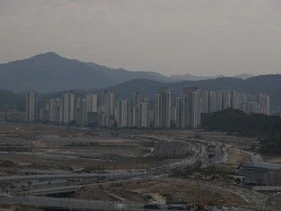
Our trip to Sejong this week was organized by the Korea Research Institute for Human Settlements (KRIHS), a partner with the World Bank’s flagship program on urbanization in South Asia. The program has formed a network of city leaders, policy makers, urban planners and practitioners from across the region to put the world’s best knowledge and data in their hands, and to harness urban growth for faster poverty alleviation and better development outcomes. The idea behind the trip was to take inspiration from Korea’s vision of becoming one of five top-ranked Green Economies by 2050 and to learn from cutting-edge Korean examples in green urban development for possible application in South Asian cities as they grow in size and numbers.
Located in the heart of the country, Sejong will be no farther than two hours away from Korea’s major cities, ports, and airports. The "city" is still a giant construction site, and our hosts from the Multifunctional Administrative City Construction Agency (MACCA) told us the Korean government plans to invest $30 billion in urban infrastructure, renewable energy, vast open landscapes, cultural and business parks, public transport networks, and residential complexes to make Sejong one of the world’s greenest urban spaces when it is completed in 2030. The city’s 500,000 residents will include officials of federal ministries and offices that are already beginning to relocate.
Named after King Sejong, who introduced Hangul, the Korean alphabet system, along with various technological advances during his reign in the 15th century, the city intends to attract the best and the brightest from Korea and the world to its specialized zones dedicated to high-tech industry, super-specialty medical services, universities, science labs, and research institutions.
As the South Asian participants discussed their own country case studies, it was apparent that a consensus still eludes the South Asia region as to what constitutes “Green” in the context of their own cities. While it was evident that the needs and demands are starkly different across South Asia, it was also apparent that many governments are already investing in making their cities environmentally sustainable, socially inclusive, and generally more livable.
From the Korean examples, the participants concluded that greening is not just about planting trees and reducing greenhouse gas emissions but, more importantly, about capturing the local “co-benefits” of carbon reduction to improve the quality of life of urban citizens. In the South Asian context, green challenges, they noted, also apply to improving metropolitan and municipal governance; basic services, planning and institutions; infrastructure financing; coping with rural-urban migration and climate change vulnerabilities; disaster preparedness; heritage conservation; engaging citizen populations more broadly in the urban agenda; and reducing the social costs of congestion which, in some cases, are manifesting in poor human development indicators or contributing to social instability and growing criminal rates.
Obviously, most South Asian countries possess neither the financial wherewithal nor the political will to drive the green urban development agenda at the scale and speed of Korea. Alternately, the emerging consensus among the South Asia participants is to maintain incremental green "top-ups" across ongoing urban investments in the region; working smarter and "doing old things in a new way," as one participant put it. The takeaway: "It’s Possible" to green South Asian cities too, albeit incrementally.


Join the Conversation